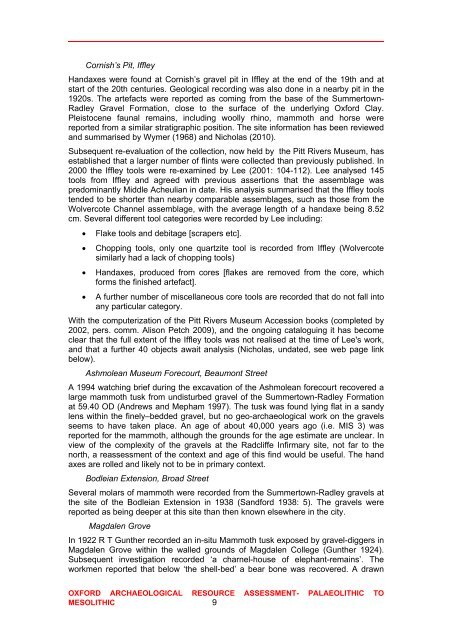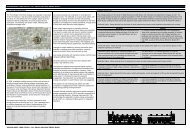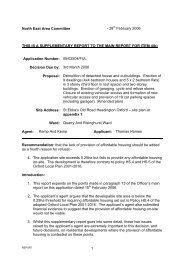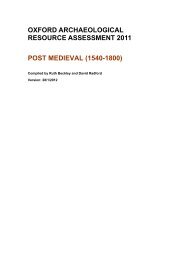Palaeolithic to Mesolithic Oxford (500000 - 4000 BC) - Oxford City ...
Palaeolithic to Mesolithic Oxford (500000 - 4000 BC) - Oxford City ...
Palaeolithic to Mesolithic Oxford (500000 - 4000 BC) - Oxford City ...
Create successful ePaper yourself
Turn your PDF publications into a flip-book with our unique Google optimized e-Paper software.
Cornish’s Pit, Iffley<br />
Handaxes were found at Cornish’s gravel pit in Iffley at the end of the 19th and at<br />
start of the 20th centuries. Geological recording was also done in a nearby pit in the<br />
1920s. The artefacts were reported as coming from the base of the Summer<strong>to</strong>wn-<br />
Radley Gravel Formation, close <strong>to</strong> the surface of the underlying <strong>Oxford</strong> Clay.<br />
Pleis<strong>to</strong>cene faunal remains, including woolly rhino, mammoth and horse were<br />
reported from a similar stratigraphic position. The site information has been reviewed<br />
and summarised by Wymer (1968) and Nicholas (2010).<br />
Subsequent re-evaluation of the collection, now held by the Pitt Rivers Museum, has<br />
established that a larger number of flints were collected than previously published. In<br />
2000 the Iffley <strong>to</strong>ols were re-examined by Lee (2001: 104-112). Lee analysed 145<br />
<strong>to</strong>ols from Iffley and agreed with previous assertions that the assemblage was<br />
predominantly Middle Acheulian in date. His analysis summarised that the Iffley <strong>to</strong>ols<br />
tended <strong>to</strong> be shorter than nearby comparable assemblages, such as those from the<br />
Wolvercote Channel assemblage, with the average length of a handaxe being 8.52<br />
cm. Several different <strong>to</strong>ol categories were recorded by Lee including:<br />
Flake <strong>to</strong>ols and debitage [scrapers etc].<br />
Chopping <strong>to</strong>ols, only one quartzite <strong>to</strong>ol is recorded from Iffley (Wolvercote<br />
similarly had a lack of chopping <strong>to</strong>ols)<br />
Handaxes, produced from cores [flakes are removed from the core, which<br />
forms the finished artefact].<br />
A further number of miscellaneous core <strong>to</strong>ols are recorded that do not fall in<strong>to</strong><br />
any particular category.<br />
With the computerization of the Pitt Rivers Museum Accession books (completed by<br />
2002, pers. comm. Alison Petch 2009), and the ongoing cataloguing it has become<br />
clear that the full extent of the Iffley <strong>to</strong>ols was not realised at the time of Lee's work,<br />
and that a further 40 objects await analysis (Nicholas, undated, see web page link<br />
below).<br />
Ashmolean Museum Forecourt, Beaumont Street<br />
A 1994 watching brief during the excavation of the Ashmolean forecourt recovered a<br />
large mammoth tusk from undisturbed gravel of the Summer<strong>to</strong>wn-Radley Formation<br />
at 59.40 OD (Andrews and Mepham 1997). The tusk was found lying flat in a sandy<br />
lens within the finely–bedded gravel, but no geo-archaeological work on the gravels<br />
seems <strong>to</strong> have taken place. An age of about 40,000 years ago (i.e. MIS 3) was<br />
reported for the mammoth, although the grounds for the age estimate are unclear. In<br />
view of the complexity of the gravels at the Radcliffe Infirmary site, not far <strong>to</strong> the<br />
north, a reassessment of the context and age of this find would be useful. The hand<br />
axes are rolled and likely not <strong>to</strong> be in primary context.<br />
Bodleian Extension, Broad Street<br />
Several molars of mammoth were recorded from the Summer<strong>to</strong>wn-Radley gravels at<br />
the site of the Bodleian Extension in 1938 (Sandford 1938: 5). The gravels were<br />
reported as being deeper at this site than then known elsewhere in the city.<br />
Magdalen Grove<br />
In 1922 R T Gunther recorded an in-situ Mammoth tusk exposed by gravel-diggers in<br />
Magdalen Grove within the walled grounds of Magdalen College (Gunther 1924).<br />
Subsequent investigation recorded ‘a charnel-house of elephant-remains’. The<br />
workmen reported that below ‘the shell-bed’ a bear bone was recovered. A drawn<br />
OXFORD ARCHAEOLOGICAL RESOURCE ASSESSMENT- PALAEOLITHIC TO<br />
MESOLITHIC 9
















